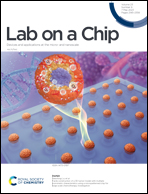Integration of silicon chip microstructures for in-line microbial cell lysis in soft microfluidics†
Abstract
The paper presents fabrication methodologies that integrate silicon components into soft microfluidic devices to perform microbial cell lysis for biological applications. The integration methodology consists of a silicon chip that is fabricated with microstructure arrays and embedded in a microfluidic device, which is driven by piezoelectric actuation to perform cell lysis by physically breaking microbial cell walls via micromechanical impaction. We present different silicon microarray geometries, their fabrication techniques, integration of said micropatterned silicon impactor chips into microfluidic devices, and device operation and testing on synthetic microbeads and two yeast species (S. cerevisiae and C. albicans) to evaluate their efficacy. The generalized strategy developed for integration of the micropatterned silicon impactor chip into soft microfluidic devices can serve as an important process step for a new class of hybrid silicon-polymeric devices for future cellular processing applications. The proposed integration methodology can be scalable and integrated as an in-line cell lysis tool with existing microfluidics assays.



 Please wait while we load your content...
Please wait while we load your content...